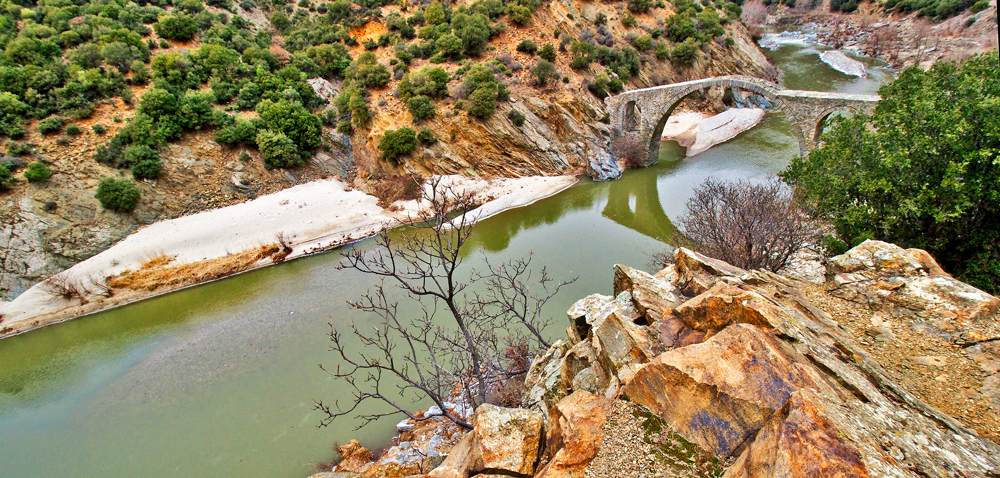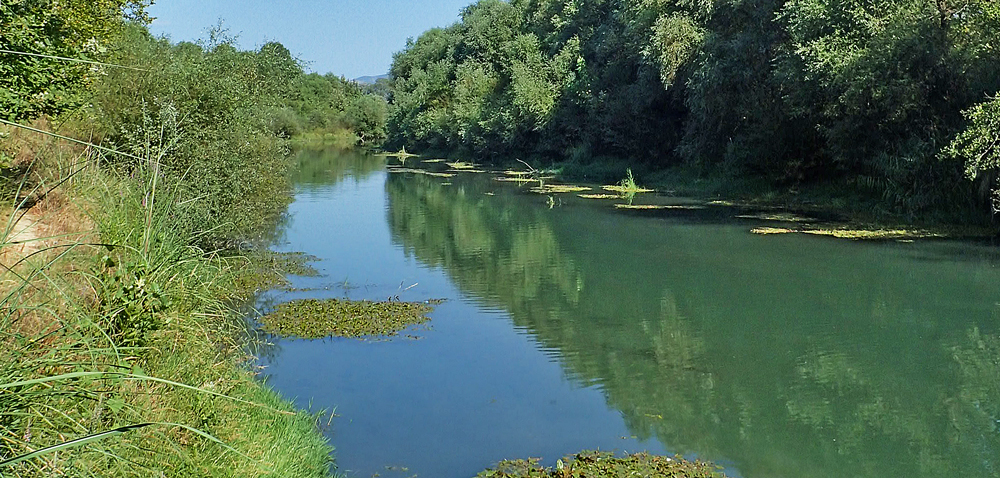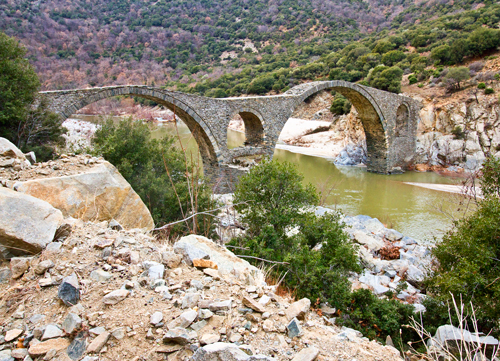Rivers
Kompsatos

A big river of Thrace, which creates a series of different habitats and hosts many rare species of mammals, birds and freshwater fishes. Kompsatos river is first mentioned and identified with the ancient Kossinitis river in “De natura animalium” written by Roman scholar Claudius Aelianus. The river is about 70 km long with a catchment area that reaches 600 sq.km. The river sources are located in the mountains of Central Rhodope, near the Greek-Bulgarian borders. The river crosses the northeast of the prefecture of Xanthi, enters the prefecture of Rhodope, passes west of Papikio mountain and flows into Vistonis lake, where it creates an extensive wetland. In its waters contribute dozens of smaller rivers and streams that descend from the mountainous Rhodope with most important Xeropotamos -which is considered the first part of Kompsatos-, Sakorema, Charadra, Kremmidorema, Drepani, Aetorema and Crystalli. Close to the exit of the river from its valley to the plain of Komotini and near the village Polyanthos, lies the impressive medieval stone arched bridge of Kompsatos. In the middle of its course and in an area of unique natural beauty stand the eminent Thracian Meteora, big rock formations similar to those of the famous Thessalian Meteora. Kompsatos is a clean river, characterised by large quantities of water, numerous meanders, sandy shores and dense riverside forests, while crossing a wide variety of habitats, such as canyons, meadows, subalpine forests, valleys, small hills, lowland plains, etc. The fact that there are no roads in the largest part of the river, creates excellent conditions for the presence of an extremely rich biodiversity.
The river springs are located in a pristine, wild area dominated by beech forests and macedonian firs. Then Kompsatos enters an area with small hills full of oaks and other deciduous species and before ends up in Vistonis, the river passes through a large plain with crops and beautiful poplar forests. On the banks grow oriental planes, maples, common alders, hornbeams, willows, field elms and others. A very rare species of Kompsatos is the endemic willow of Xanthi (Salix xanthicola) that grows in a few places on the banks of the river. The most important plants in the area are Haberlea rhodopensis, Erythronium dens-canis, Telekia speciosa, Petasites kablikianus, Hypericum aucheri, Festuca oviniformis, Dianthus gracilis subsp. drenowskianus, Doronicum hungaricum, Aquilegia vulgaris and Paeonia peregrina. Other interesting plants are Lilium martagon, Asphodeline taurica, Geum coccineum, Jasione heldreichii, Petasites albus, Pulmonaria rubra, Thalictrum aquilegiifolium, Dianthus cruentus, Lysimachia punctata, Prunella grandiflora, Achillea chrysocoma, Achillea grandifolia, Aristolochia clematitis, Iris reichenbachii, Arctium lappa, Geranium macrorrhizum, Geranium sanguineum, Sorbus aucuparia subsp. aucuparia, Campanula lingulata, Campanula persicifolia, Campanula cervicaria, Campanula moesiaca, Digitalis viridiflora, Silene subconica, Silene atropurpurea, Eupatorium cannabinum, Salvia verticillata subsp. verticillata, Cardamine bulbifera, Galeopsis bifida, Moehringia pendula, Rorippa thracica, Symphytum ottomanum, Buglossoides purpurocaerulea, Globularia bisnagarica, Hypericum cerastioides, Knautia orientalis, Viola riviniana and Viola tricolor. Orchids include Cephalanthera damasonium, Cephalanthera longifolia, Epipactis helleborine, Neottia nidus-avis, Neottia ovata, Gymnadenia conopsea, Dactylorhiza saccifera, Anacamptis morio, Anacamptis laxiflora, Neotinea tridentata, Orchis simia, Orchis purpurea and Ophrys mammosa.
The river springs are located in a pristine, wild area dominated by beech forests and macedonian firs. Then Kompsatos enters an area with small hills full of oaks and other deciduous species and before ends up in Vistonis, the river passes through a large plain with crops and beautiful poplar forests. On the banks grow oriental planes, maples, common alders, hornbeams, willows, field elms and others. A very rare species of Kompsatos is the endemic willow of Xanthi (Salix xanthicola) that grows in a few places on the banks of the river. The most important plants in the area are Haberlea rhodopensis, Erythronium dens-canis, Telekia speciosa, Petasites kablikianus, Hypericum aucheri, Festuca oviniformis, Dianthus gracilis subsp. drenowskianus, Doronicum hungaricum, Aquilegia vulgaris and Paeonia peregrina. Other interesting plants are Lilium martagon, Asphodeline taurica, Geum coccineum, Jasione heldreichii, Petasites albus, Pulmonaria rubra, Thalictrum aquilegiifolium, Dianthus cruentus, Lysimachia punctata, Prunella grandiflora, Achillea chrysocoma, Achillea grandifolia, Aristolochia clematitis, Iris reichenbachii, Arctium lappa, Geranium macrorrhizum, Geranium sanguineum, Sorbus aucuparia subsp. aucuparia, Campanula lingulata, Campanula persicifolia, Campanula cervicaria, Campanula moesiaca, Digitalis viridiflora, Silene subconica, Silene atropurpurea, Eupatorium cannabinum, Salvia verticillata subsp. verticillata, Cardamine bulbifera, Galeopsis bifida, Moehringia pendula, Rorippa thracica, Symphytum ottomanum, Buglossoides purpurocaerulea, Globularia bisnagarica, Hypericum cerastioides, Knautia orientalis, Viola riviniana and Viola tricolor. Orchids include Cephalanthera damasonium, Cephalanthera longifolia, Epipactis helleborine, Neottia nidus-avis, Neottia ovata, Gymnadenia conopsea, Dactylorhiza saccifera, Anacamptis morio, Anacamptis laxiflora, Neotinea tridentata, Orchis simia, Orchis purpurea and Ophrys mammosa.
The area around Kompsatos is considered one of the most important areas in Greece for birds, especially for predators. Until a few years ago the region hosted breeding pairs of imperial eagles, egyptian vultures an griffon vultures. Birds of pray include white-tailed eagles, lesser spotted eagles, spotted eagles, short-toed eagles, booted eagles, black kites, marsh harriers, hen harriers, common buzzards, honey buzzards, sparrowhawks, levant sparrowhawks, goshawks, kestrels, red-footed falcons, hobbies, peregrines and rare lanner falcons. The night predators are represented by six species: tawny owls, eagle owls, Tengmalm’s owls, long-eared owls, barn owls and little owls. Close to the river live black storks, white storks, little bitterns, night herons, grey herons, purple herons, great egrets, stone curlews, lapwings, green sandpipers, snipes, grey wagtails and dippers. On the open plains are found two rare species, the little bustard and the grey partridge. In the forests live eight species of woodpeckers: black, grey-headed, green, great spotted, middle spotted, lesser spotted, white-backed and three-toed. The avifauna include also quails, woodcocks, woodpigeons, turtle doves, cuckoos, nightjars, swifts, alpine swifts, kingfishers, hoopoes, bee eaters, rollers, skylarks, woodlarks, calandra larks, wrens, dunnocks, nightingales, stonechats, blue rock thrushes, mistle thrushes, whitethroats, barred warblers, Cetti’s warblers, semicollared flycatchers, coal tits, long-tailed tits, red-backed shrikes, masked shrikes, nutcrackers, jays, starlings, golden orioles, linnets, serins, hawfinches, bullfinches, crossbills, yellowhammers and cirl buntings.
Amphibians include fire salamanders, balkan crested newts, toads, green toads, yellow-bellied toads, tree frogs, marsh frogs, agile frogs and rare eastern spadefoots. The herpetofauna is just as rich with species like pond turtles, greek tortoises, Hermann’s tortoises, slow worms, glass lizards, mediterranean house geckos, sand lizards, green lizards, common wall lizards, balkan wall lizards, snake-eyed lizards, snake-eyed skinks, sand boas, worm snakes, smooth snakes, large whip snakes, blotched snakes, levant montpellier snakes, grass snakes, dice snakes, Dahl’s whip snakes, cat snakes, aesculapian snakes, leopard snakes, ottoman vipers and nose-horned vipers. Close to the springs of Kompsatos live brown bears, roe deers and wolves, while the latter appears also lower in oak forests. A very important species of polecat is found near lake Vistonis, the beautiful marbled polecat (Vormela peregusna). The river still holds many otters and in the lowlands golden jackals are quite abundant. The mammal fauna include also wildcats, foxes, ground squirrels, wild boars, badgers, weasels, pine martens, red squirrels, eastern hedgehog and harvest mouses. The presence of bats is also important, with species such as the greater noctule (Nyctalus lasiopterus), the lesser noctule (Nyctalus leisleri), the Daubenton’s bat (Myotis daubentonii), the Mehely’s horseshoe bat (Rhinolophus mehelyi) and the alpine long-eared bat (Plecotus macrobullaris).
The fish fauna of the river consists of many rare and endemic species like the vistonis shemaja (Alburnus vistonicus), the struma spined loach (Cobitis strumicae), the thracian barbel (Barbus cyclolepis), the western three-spine stickleback (Gasterosteus gymnourus), the struma stone loach (Oxynoemacheillus bureschi) and the black sea chub (Petroleuciscus borysthenicus). Other species are european eels (Anguilla anguilla), prusian carps (Carassius gibelio), european carps (Cyprinus carpio), aegean gudgeons (Gobio bulgaricus), european bitterlings (Rhodeus amarus), common roaches (Rutilus rutilus), freshwater blennies (Salaria fluviatilis) and maritza chubs (Squalius orpheus).
Amphibians include fire salamanders, balkan crested newts, toads, green toads, yellow-bellied toads, tree frogs, marsh frogs, agile frogs and rare eastern spadefoots. The herpetofauna is just as rich with species like pond turtles, greek tortoises, Hermann’s tortoises, slow worms, glass lizards, mediterranean house geckos, sand lizards, green lizards, common wall lizards, balkan wall lizards, snake-eyed lizards, snake-eyed skinks, sand boas, worm snakes, smooth snakes, large whip snakes, blotched snakes, levant montpellier snakes, grass snakes, dice snakes, Dahl’s whip snakes, cat snakes, aesculapian snakes, leopard snakes, ottoman vipers and nose-horned vipers. Close to the springs of Kompsatos live brown bears, roe deers and wolves, while the latter appears also lower in oak forests. A very important species of polecat is found near lake Vistonis, the beautiful marbled polecat (Vormela peregusna). The river still holds many otters and in the lowlands golden jackals are quite abundant. The mammal fauna include also wildcats, foxes, ground squirrels, wild boars, badgers, weasels, pine martens, red squirrels, eastern hedgehog and harvest mouses. The presence of bats is also important, with species such as the greater noctule (Nyctalus lasiopterus), the lesser noctule (Nyctalus leisleri), the Daubenton’s bat (Myotis daubentonii), the Mehely’s horseshoe bat (Rhinolophus mehelyi) and the alpine long-eared bat (Plecotus macrobullaris).
The fish fauna of the river consists of many rare and endemic species like the vistonis shemaja (Alburnus vistonicus), the struma spined loach (Cobitis strumicae), the thracian barbel (Barbus cyclolepis), the western three-spine stickleback (Gasterosteus gymnourus), the struma stone loach (Oxynoemacheillus bureschi) and the black sea chub (Petroleuciscus borysthenicus). Other species are european eels (Anguilla anguilla), prusian carps (Carassius gibelio), european carps (Cyprinus carpio), aegean gudgeons (Gobio bulgaricus), european bitterlings (Rhodeus amarus), common roaches (Rutilus rutilus), freshwater blennies (Salaria fluviatilis) and maritza chubs (Squalius orpheus).
Πως θα πάτε
The mouth of Kompsatos on Lake Vistonis is 252 km from Thessaloniki, via Egnatia National Road. If you want to explore the springs of the river turn to Xanthi, head to Echinos and then to Thermes. The river, for the most part, does not meet any roads and so it becomes more exciting as you have to walk.Εμφάνιση στο χάρτη
click to see the place on the map(Latitude: 41.10035612258995, Longitude:25.217452047078723)
Social Networks
Also Read

Sperchios
The imposing river of Central Greece is distinguished for its pristine physiognomy, retaining its ancient course from the springs to its beautiful estuary.

Venetikos
A river that flows between some of the larger rivers of Greece, connects the mountains of Epirus with the plains of Grevena and forms landscapes of great aesthetic value.












